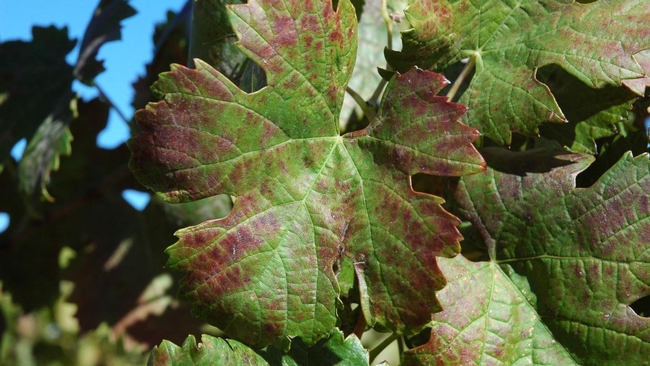
Posts Tagged: College of Agricultural and Environmental Sciences
Bill Patterson and Doris Brown: Friends of CA&ES and Friends of Bohart Museum
The UC Davis College of Agricultural and Environmental Sciences (CA&ES) annually singles out individuals "for their achievements, support, leadership and service to the college with an Award of Distinction honoring those contributions." So wrote Helene Dillard, dean of CA&ES, in her...
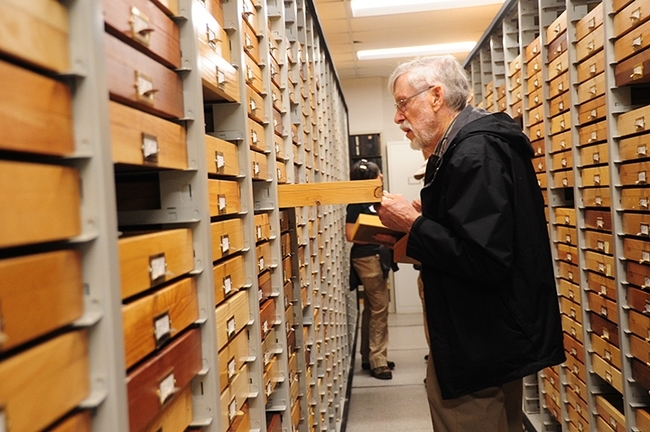
Entomologist and butterfly collector Bill Patterson looks through a drawer during the international Lepidopterists' Society meeting in 2017 at UC Davis. (Photo by Kathy Keatley Garvey)
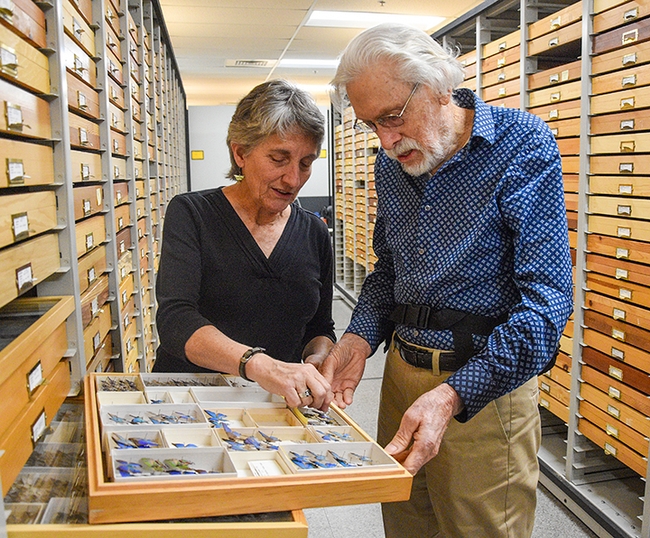
Lynn Kimsey, director of the Bohart Museum, looks through specimens with Bill Patterson. (Photo by Ashley Han)
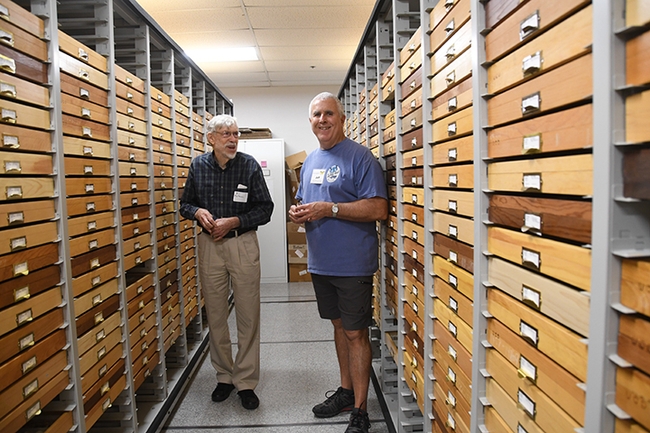
Entomologist and butterfly collector Bill Patterson chats with entomologist Jeff Smith, curator of the Lepidoptera collection at the Bohart Museum, during the international Lepidopterists' Society meeting in 2017 at UC Davis. Both are recipients of the CA&ES Friend of the College Award: Patterson in 2022, and Smith in 2015. (Photo by Kathy Keatley Garvey)
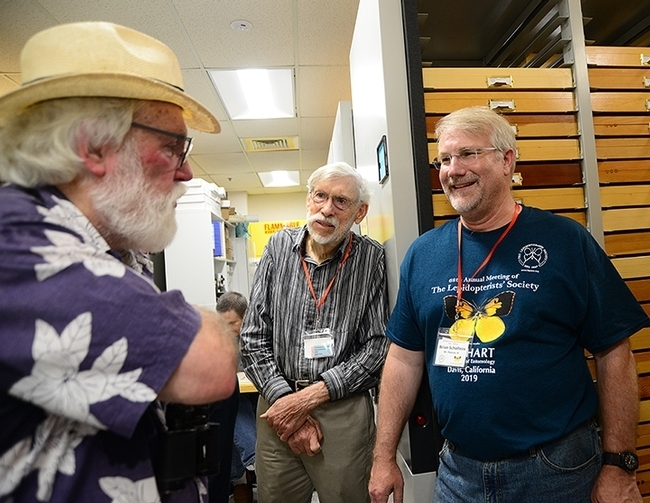
Entomologist Bill Patterson (center) of Sacramento and the international Lepidopterists' Society president Brian Scholtens (right), entomology professor at the College of Charleston, South Carolina, discuss butterflies with scientist-author Robert Michael Pyle, founder of the Xerces Society for Invertebrate Conservation. UC Davis hosted the 2017 meeting of the Lepidopterists. (Photo by Kathy Keatley Garvey)
Congrats to Honey Bee Geneticist Rob Page!
Congratulations to UC Davis-trained bee scientist Robert E. Page Jr., recipient of the 2022 Exceptional Emeriti Faculty Award from the UC Davis College of Agricultural and Environmental Sciences (CA&ES). Known by his colleagues as “the leading honey...
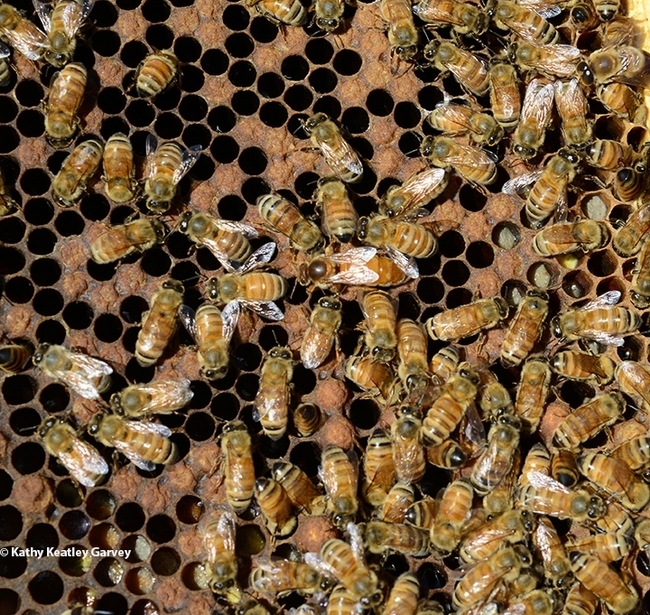
Inside a honey bee colony. (Photo by Kathy Keatley Garvey)

Rob Page as a doctoral student, with his major professor (and collaborator) Harry Hyde Laidlaw Jr.
UC Davis to build new $5.25M greenhouse to protect U.S. grapevine collection
Project designed to prevent red blotch and other grapevine diseases
A new, $5.25 million greenhouse is being built on the University of California, Davis, campus to safeguard an important grapevine collection from red blotch disease and other pathogens.
The 14,400-square-foot greenhouse will have a vestibuled entry, be insect-proof and provide another level of disease protection. It is being spearheaded by Foundation Plant Services, or FPS, which provides the U.S. grape industry with high-quality, virus-tested grapevine plant material.
The program serves as the primary source for grapevine plant material distributed to nurseries under the California Department of Agriculture's Grapevine Registration and Certification Program, which provides the majority of grapevines planted in the United States. For the grape industry, it is essential to protect this material from disease-carrying insects and guarantee fast access to clean plant material.
“The program is considered the largest quarantine center for the grapevine industry in the United States,” said Maher Al Rwahnih, a plant pathologist and FPS director. “This is kind of a game changer for us.”
A history of serving the grapevine industry
FPS has maintained healthy grapevine planting stock on the UC Davis campus for more than 70 years in open fields at the Classic and Russell Ranch foundation vineyards. FPS scientists first detected grapevine red blotch virus at Russell Ranch in 2017. By 2021, an estimated 51.6% of the crop there was infected. Material from that vineyard is not being sold, and the site is now part of an epidemiological study to try to pinpoint how the disease is transmitted.
FPS pathologists have detected red blotch on less than 1% of the Classic vineyard crop. But it may not always be that way in the future.
“We don't know how long the Classic vineyard will remain clean,” Al Rwahnih said. “Every testing season, this is what keeps me up at night. We're not sure why it's happening in Russell Ranch and not the Classic vineyard.”
Once the greenhouse is operating, grapevines propagated from plant material from the Classic vineyard will be moved into the greenhouse, tested and verified as clean from disease. From there it will be sold to nurseries, which will grow additional plants to sell to growers.
Two greenhouses part of plan
Normally the foundation has 4,000 vines available, but the greenhouse will only house 2,000 vines, so inventory will be cut in half.
“This phase is just a starting phase,” Al Rwahnih said. “It's not sufficient for our needs.”
FPS plans to build another greenhouse in the next two to three years to increase capacity.
Industry groups and FPS identified greenhouses as the best way to protect the plants from red blotch and other pathogens transmitted by insects. They are also consulting with those same people on the grape varieties to include in the greenhouse.
“We have a large selection, and we need to make sure all the varieties that are important to industry are contained,” he said.
The first greenhouse is expected to be finished by the end of 2023.
Funding for the first greenhouse is coming from a variety of sources. The California Fruit Tree, Nut Tree and Grapevine Improvement Advisory Board, managed by the California Department of Food and Agriculture, contributed $4 million to the project. The California Grape Rootstock Research Foundation gave $500,000, Foundation Plant Services with UC Davis is funding $450,000, and the California Grape Rootstock Commission gave $100,000.
“This is crucial for the grapevine industry, and we are very grateful for the support,” Al Rwahnih said.
Should there be more microbes on your plate?
Scientists make the first large-scale estimate of live microorganisms consumed in the U.S. diet
Our diets provide us with the building blocks we need to stay healthy and fight disease. The nutrients in foods and beverages can be tallied up to know if we are getting what our bodies need. Yet what if a nutrient has been overlooked? For instance, friendly microbes in raw and fermented foods have not been measured as part of our diets — until now.
“Ultimately we want to understand if there should be a recommended daily intake of these microbes to keep us healthy, either through the foods or from probiotic supplements,” said Maria Marco, a professor in the food science and technology department at UC Davis. “In order to do that, we need to first quantify the number of live microorganisms we consume today in our diets.”
Marco co-authored a new study with a group of scientists that examined the number of living microbes per gram of more than 9,000 different foods consumed by nearly 75,000 adults and children. It found that around 20% of children and 26% of adults consumed foods with high levels of live microorganisms in their diet. Both children and adults increased their consumption of these foods over the 18-year study period. The study, published in the Journal of Nutrition, is the first large-scale estimate of how many live microbes are consumed by Americans every day.
“This trend is going in the right direction. Exposure to friendly microorganisms in our foods can be good for promoting a healthy immune system.” said Marco.
Foods for gut health
Study authors examined the National Health and Nutrition Examination Survey to create the estimate. The health and dietary database contains extensive information on the foods consumed by Americans daily. Food science and fermentation experts assigned each food an estimated range of live microbes per gram, creating categories of foods with low, medium and high levels of live microbes. Foods in the high category included fermented dairy foods such as yogurt, fermented pickles and kimchi. Fresh, uncooked fruits and vegetables were also good sources of live microorganisms, represented in the medium category.
The analysis was funded by a grant from the International Scientific Association for Probiotics and Prebiotics, or ISAPP. The microorganisms quantified in this study are not necessarily probiotics.
“By definition, a probiotic must be well-defined and have a demonstrated health benefit at a quantified dose. Live microbes associated with food as a category, however, do not generally meet the criteria of a probiotic,” said corresponding author Mary Ellen Sanders, executive science officer for the ISAPP.
The publication is part of a larger global effort to determine how live dietary microbes might contribute to health.
“There is no doubt that the microbes we eat affect our health. When we think of microbes in our food, we often think of either foodborne pathogens that cause disease or probiotics that provide a documented health benefit,” said co-author Colin Hill, a professor of microbial food safety with University College Cork, Ireland. “But it's important to also explore dietary microbes that we consume in fermented and uncooked foods. It is very timely to estimate the daily intake of microbes by individuals in modern society as a first step towards a scientific evaluation of the importance of dietary microbes in human health and well-being.”
Other scientists co-authoring the paper were ISAPP board members Robert Hutkins, Dan Merenstein, Daniel J. Tancredi, Christopher J. Cifelli, Jaime Gahche, Joanne L. Slavin and Victor L. Fulgoni III.
Editor's note: Maria Marco is affiliated with UC Agriculture and Natural Resources as an Agricultural Experiment Station faculty member.
Can vines speed urban cooling?
Study explores cooling benefits of fast-growing vines as trees take their time
Perhaps trees aren't the only green solution when it comes to cooling urban spaces and reducing energy costs. Honeysuckle, Virginia creeper, pink trumpet and other vines could be a fast-growing substitute in climate-smart cities of the future.
Researchers from UC Davis are leading a nearly $880,000 federal grant to study how vines may provide cooling and shade in Western states in less time than it takes a tree to grow tall.
“Vines can quickly shade buildings and reduce energy consumption while trees slowly grow to maturity,” said Alessandro Ossola, an assistant professor of plant sciences who is a principal investigator for the project. “We believe vines can be an effective and cheap measure to help cities accelerating climate change adaptation.”
The grant from the U.S. Department of Agriculture's Agricultural Marketing Service will fund work to plant and monitor at least 10 types of vines on trellises in five locations in different climate zones over three years. California Department of Food and Agriculture is administering the grant.
Using less water
Water conservation will be vital as populations rise, climate extremes become more prevalent and the demand for agricultural and drinking water increases. The goal of this research is to identify vines that can help save energy by providing cooling and reduce the need for irrigated water.
“In addition to rapid growth rates, vines can be easily integrated with structures to maximize potential cooling effects,” said Loren Oki, a Cooperative Extension specialist with Department of Plant Sciences, who is the project lead. “But we need to understand the relationships between low water-use plants and their ability to reduce thermal loads on buildings.”
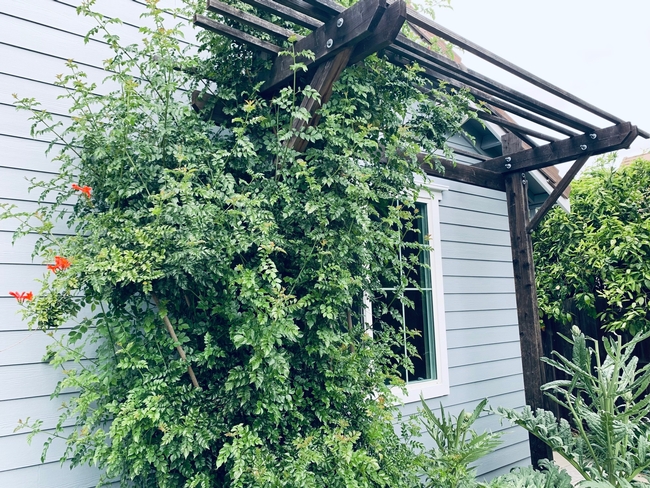
The vines will be planted, supported by a trellis and watered regularly during the first growing season to establish deep roots and healthy shoots. Over the next two years, the vines will experience low, moderate and high water allocations.
The vines will be rated on aesthetics, foliage quality, floral quantity, pest and disease resistance, appearance and other factors. Thermal images of trellis coverage and other environmental measurements will also be taken to assess shading and cooling potential, according to grant documents.
Many vines can be grown along cables and wire nets that are actually detached from walls to avoid direct contact and still provide shade, Ossola said.
“We want to understand which vine characteristics relate to fast growth, reduced water use and increased aesthetic appeal,” he added.
Outreach and education
The findings will enable recommendations to be developed for regions, planners, the landscape industry and the public. It could lead to plants being designated as “water-wise,” “low-water use,” “energy-saving” or “cooling.”
Extensive engagement and outreach will also publicize the information.
“Climate change is a great opportunity for the horticultural industry to innovate and promote climate-ready plant productions,” Ossola said.
USDA funding supports research across state lines to find innovative solutions to regional and national problems, USDA Under Secretary for Marketing and Regulatory Programs Jenny Lester Moffitt said in a news release announcing this and other grants.
“This year's funded projects will address a range of those challenges, from energy and water saving in vine plants, finding cost-effective solutions for heat tolerance and drought, to addressing food safety risks for produce,” Moffitt said.
Scientists from the University of Arizona, University of Washington, Utah State University and the South Coast Research and Extension Center at UC Agricultural and Natural Resources are contributing to the research and will be overseeing vine sites in their states.
This article is reprinted from the UC Davis College of Agricultural and Environmental (CA&ES) website, where it is titled "Could Vines Be the Answers to Speeding Urban Cooling, Water Reduction in the West?"

